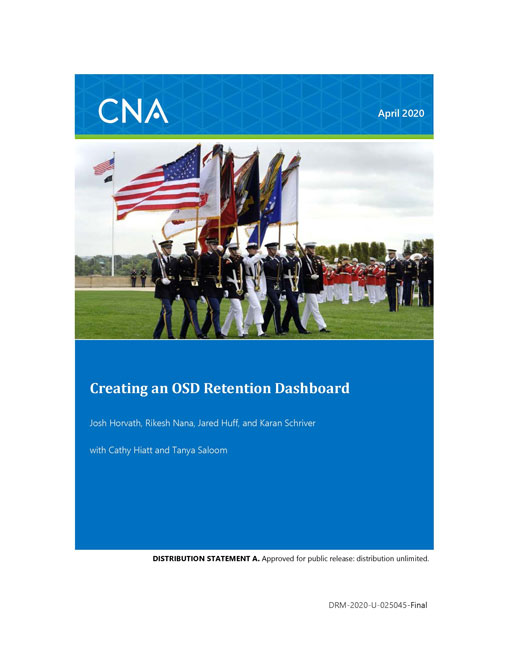The past two decades have reflected constantly changing retention environments, driven by factors including the post-9/11 increase in willingness to serve, the strong civilian economies of the mid-2000s, and the Great Recession and its lingering aftermaths. These changes have resulted in changes to retention policy and retention incentive requirements. Oversight of these policies by the Office of the Secretary of Defense (OSD) Personnel and Readiness (P&R) has been complicated by the services’ use of different retention measures, making direct comparisons across services difficult.
In this report, CNA facilitates OSD’s efforts to oversee retention policies in two ways:
- We define several retention measures that are consistently measured across the services
- We calculate and display these metrics in an interactive retention dashboard We define four retention measures:
- The continuation rate measures the share of servicemembers who remain in the military from one year to the next. Those who fail to retain encompass all types of losses, including servicemembers who leave while still under contract with the military
and those who leave at the end of their contract. - The cumulative continuation rate measures the share of servicemembers who have retained from accession to a particular year of service; this is essentially an aggregation of continuation rates for each year from accession to present.
- The reenlistment rate contrasts the number of servicemembers who reenlisted1 with the number of servicemembers who were eligible to reenlist but left at the end of their contracts.
- The end-of-contract (EOC) cohort reenlistment rate measures reenlistment behavior for servicemembers with contracts ending in a particular fiscal year.
We illustrate these rates in the retention dashboard that accompanies this document. This document serves as a basic “user guide” for that dashboard and describes some of its limitations (and the limitations of other, similar, dashboards). Chief among these limitations are constraints due to privacy concerns related to the use of personally-identifiable individuallevel data. These concerns forced us to compute predetermined measures of interest in aggregate to not risk exposing individual level data. Although we chose a large set of precomputed measures to allow for user flexibility, this and similar dashboards cannot offer the same level of flexibility as dashboards that have “live” access to databases that contain personally identifiable information (PII).
Finally, we highlight some considerations for future dashboard iterations, focusing on predictive capabilities. Although the current dashboard has no predictive component, we note the effect of using aggregated versus PII data on (likely) forecast accuracy. Previous work has shown that the national unemployment rate is an insufficient summary of civilian economic conditions, and we show that even using unemployment rates that seem more suitable for the population in question (e.g., high school graduates age 25 and older) does not overcome this insufficiency. Instead, we suggest using one or more broader (but still forecastable) measures of economic conditions.
Download reportDISTRIBUTION STATEMENT A. Approved for public release: distribution unlimited. Public Release.
This work was performed under Federal Government Contract No. N00014-16-D-5003.
Details
- Pages: 54
- Document Number: DRM-2020-U-025045-Final
- Publication Date: 4/1/2020
